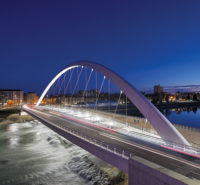Until 2012, a visitor to downtown Newark would have encountered a bleak expanse of asphalt and weathered facades. Teachers Village, a new six-building mixed-use development, however, is helping to transform the cityscape by cultivating community, energizing street life, and supporting education. Construction of the 400,000-square-foot complex’s final building is currently under way and is scheduled for completion this spring.
The project, which was masterplanned by Richard Meier & Partners Architects, comprises three charter schools, an early learning center, retail space, and 123 residential rental units—20 percent of which are affordable (teachers are given priority for housing).
Meier & Partners designed the three completed residential buildings, which were constructed with prefabricated panelized steel bearing walls. The other three structures resulted from collaboration with KSS Architects, a Princeton, New Jersey– and Philadelphia-based firm specializing in academic and mixed-use facilities. Richard Meier’s trademark white aluminum facade unifies the Teachers Village, although the schools employ brick cladding that relates to the surrounding urban fabric. According to project manager Vivian Lee, integrating the complex properly into the historic milieu of Newark was important; in accordance with the Newark Living Downtown redevelopment plans, buildings do not exceed 60 feet in height.
As one of the first communities to pursue a LEED Neighborhood Development designation by the U.S. Green Building Council, the architecture features generous window openings with high-performance glass. These not only bring in natural light but also allow transparency between inside and the street—a testament to the evolving downtown.
The $150 million project was developed by Newark-based RBH Group and funded by a variety of financial institutions, individual investors, and city, state, and federal governments. Through its program, ambition, and location, the project also earned substantial tax subsidies, including the federal New Markets and state Urban Transit Hub credits. A short jaunt from Newark Penn Station, Teachers Village is an accessible landing pad.
But why a “teachers” village? According to RBH CEO Ron Beit, it was critical that the project receive public investment. As builders of the first ground-up residential construction in Newark in decades, he says, “we needed to create a tool or a benefit for the community, and we became inspired by the teachers who were working in Newark.” In addition, it’s a recruitment tool that aims to attract top-tier teachers to the city.








Post a comment to this article
Report Abusive Comment